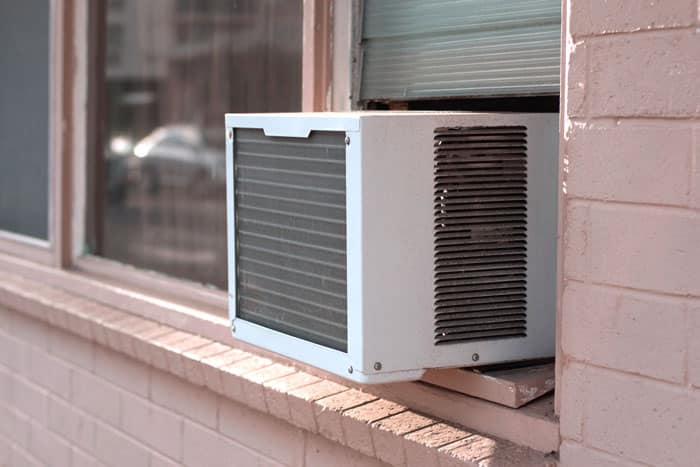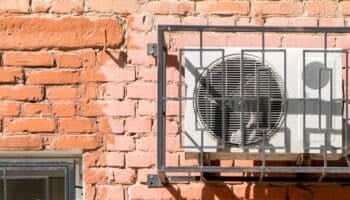We've independently reviewed this article to make sure it's as accurate as we can make it.
To find out more about our article creation and review process, check out our editorial guidelines.
It’s your worst nightmare.
It’s a broiling hot summer day and while you don’t have central air, you do have a window air conditioner, and the fan is not spinning! Of course, if that’s happening, your air conditioner isn’t cooling you at all.
Okay. Take a deep—hot—breath and find your Zen. You’ve come to the right place, and we’ll help you diagnose and fix the issue. And if you’re lucky, you won’t even need to take a trip to the store for any necessary tools to help you work your magic.
In a nutshell, a few main reasons for the fan to stop working on a window AC unit are a motor with worn-out bearings, a burned-out motor, dirty blades, electrical problems, debris in the cabinet, a dead capacitor, and more.
Let’s address the possible problems and fix yours before you’re nothing more than a puddle on the floor.
What You’ll Need
Your tools will depend on what needs to be fixed, so figure that part out first. You likely won’t need everything on the list below.
- Screwdriver
- Allen key
- Small hand broom or vacuum cleaner
- Spray bottle with mild soap and water
- Multimeter
- WD-40
But first, a few important notes.
Before you start doing anything, make sure you unplug your air conditioner.
It’s also a good idea to remove the air conditioner from the window before you start diagnosing any problems or doing any repairs. Just note that they are very heavy, and you may need help lifting it.

Clean and Remove Debris from the AC’s Housing
If it’s been a long time since you last opened your air conditioner and cleaned it, or if you’ve never done it at all, there’s a good chance there’s a lot of debris inside.
If that’s the case, something could be obstructing the movement of your fan. So before you do anything, start off with a thorough cleaning. And as a side note, keeping your air conditioner clean will help cut down on running costs.
1. Unplug your air conditioner.
2. Remove from the window.
3. Remove the front panel. Depending on your model, you may need a screwdriver, or the panel may simply be fastened with clamps or clips.
4. Remove the filter. If it’s filthy, put it aside to clean later.
5. Using a vacuum cleaner or a small hand broom, remove all debris within.
6. Move on to the next step.
Clean and Inspect AC Fan Blades
Now that you’ve cleaned the inside of your window air conditioner cabinet, it’s time to pay specific attention to the fan, the blades, and the motor.
1. Check for any buildup of dirt or pet hair on the fan blades and motor housing, and then thoroughly clean.
2. Check to see if the blades have come loose from the shaft. If they have, they can usually be tightened with a screwdriver or Allen wrench. If your air conditioner has a round vent fan, you’ll have to use a long-blade screwdriver to access it.
3. Test the fan blades to see if you can move them easily by hand. If not, are they bent or rubbing against the fan housing?
4. If yes, move to the next step.
Check and Fix Window AC Motor Bearings
If your fan blades are bent, this may be a sign that the bearings in the motor are shot. To test this, do the following.
1. Hold one of the fan blades and see if you can move the shaft from side to side. If there’s significant movement, then this indicates bad bearings. Unfortunately, bad bearings mean that your motor will need to be replaced.
If the blades are not bent and don’t turn easily, try the following.
1. Use a penetrating oil like WD-40 and generously spray the bearings. Once done, try to turn the blades by hand again. If they begin to move, plug your air conditioner in and test to see if the fan is now operating properly.
Test and Replace the Fan Motor
If the bearings are bad, the motor probably needs to be replaced. However, you can test the motor with a multimeter.
To test, do the following.
1. Remove the motor by disconnecting the terminal wires from their terminals, and then attach the multimeter’s probes to the wires. If you get a reading between three and 30 ohms, your fan motor is in good condition. However, if your reading is not within that range, the motor needs to be replaced.
To replace the fan motor, do the following.
If the multimeter test indicates the need for replacement, you can take the motor to a local appliance supply store and ask for assistance in getting an exact replacement. If you have the option of OEM equipment or aftermarket parts, it’s typically better to go with the original — OEM — equipment.
To replace your new motor, simply reverse the steps you took to remove it.
If you want to get any replacement part – or see how much one would cost – click to enter your model number in the search bar below. Our partners at AppliancePartsPros stock almost every part with free guides on how to install them.

Inspect and Replace the Capacitor
Among other things, the capacitor helps the fan motor on your window air conditioner run. If it’s faulty, it can’t deliver sufficient power to the motor and other components.
1. Visually inspect to see if the capacitor is swollen. If yes it needs to be replaced.
2. Capacitors can be tested, but if you have no electrical or HVAC experience, this is best done by a pro. However, here is more detail on the process, especially how to discharge the capacitor.
Conclusion
As we’ve detailed above, there are many reasons for a window air conditioner fan to stop spinning. Some, or most, are relatively simple fixes. In fact, it may be something as simple as cleaning your air conditioner.
Again, here are the steps to take if your window air conditioner fan is no longer spinning.
- Check and remove debris and dirt from your air conditioner
- Clean and inspect the fan blades
- Check and fix motor bearings
- Test and replace the fan motor
- Inspect and replace the capacitor
Keep in mind that all HVAC equipment performs better and lasts longer when you keep up with regular maintenance, including cleaning.
Thanks for taking the time to read this through. And while you’re here, why not check out the related articles below? Perhaps we can help you with something else.







